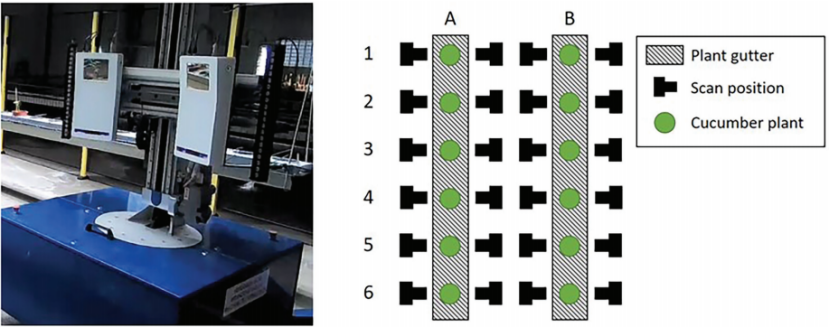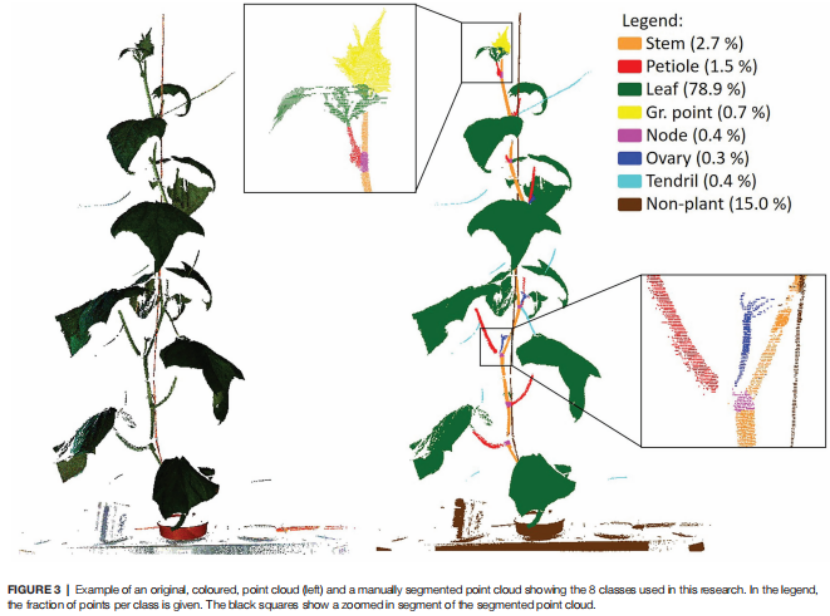品质至上,客户至上,您的满意就是我们的目标
当前位置: 首页 > 新闻动态
欧洲科学家利用WIWAM植物表型成像系统在Front. Plant Sci.发表文章
发表时间: 点击:640
来源:北京博普特科技有限公司
分享:

WIWAM植物表型成像系统
来自欧洲的科学家利用WIWAM植物表型成像系统在知名期刊Front. Plant Sci.发表了题为“Improved Point-Cloud Segmentation for Plant Phenotyping Through Class-Dependent Sampling of Training Data to Battle Class Imbalance”的文章。
通过训练数据的类相关采样改进植物表型的点云分割以对抗类不平衡
植物科学家和育种家需要高质量的表型数据。然而,由于涉及的劳动力要求很高,为大型植物种群获得准确的手动测量通常是不可行的。对于更复杂的植物性状尤其如此,比如定义植物结构的性状。计算机视觉方法可以帮助解决这个瓶颈。目前的工作集中在使用3D点云数据获取与植物结构相关的性状表型数据集的方法上。第一步是将点云分割成植物器官。点云分割中的一个问题是,并非所有的植物部分在数据中都有相同的表示,而且少数类的分割性能通常低于多数类。为了解决这个类不平衡的问题,我们使用了一种常见的做法,将大型点云划分为块,然后进行独立分割和重新组合。在例子中,这些块是通过选择锚定点并将这些锚定点与附近的点组合而成的。作为基线,以独立于类别的方式选择锚定点,代表原始数据中的类别分布。然后,我们提出了一种与类相关的抽样策略来对抗类不平衡。首先分析了独立于类和依赖于类的训练集在分割性能上的差异。此外,还研究了作为邻域选择的点数的影响。较小的区导致了更高水平的阶级平衡,但也导致了锚定点周围各点所包含的语境的丧失。当使用依赖于类的训练集时,整体分割质量(以联合上的平均交集(IoU)衡量)从0.94增加到0.96。在“节点”中,类进步最大,正确分段分数的百分比增加了46.0个百分点。第二个实验的结果清楚地表明,更高水平的类平衡并不一定会导致更好的分割性能。相反,每个类的最佳邻里规模各不相同。综上所述,我们的类相关抽样策略提出了一种改进的植物表型点云分割方法。


Improved Point-Cloud Segmentation for Plant Phenotyping Through Class-Dependent Sampling of Training Data to Battle Class Imbalance
Frans P. Boogaard1,2*, Eldert J. van Henten1 and Gert Kootstra1
1Wageningen University & Research, Farm Technology Group, Wageningen, Netherlands
2Rijk Zwaan Breeding, Fijnaart, Netherlands
Plant scientists and breeders require high-quality phenotypic data. However, obtaining accurate manual measurements for large plant populations is often infeasible, due to the high labour requirement involved. This is especially the case for more complex plant traits, like the traits defining the plant architecture. Computer-vision methods can help in solving this bottleneck. The current work focusses on methods using 3D point cloud data to obtain phenotypic datasets of traits related to the plant architecture. A first step is the segmentation of the point clouds into plant organs. One of the issues in point-cloud segmentation is that not all plant parts are equally represented in the data and that the segmentation performance is typically lower for minority classes than for majority classes. To address this class-imbalance problem, we used a common practice to divide large point clouds into chunks that were independently segmented and recombined later. In our case, the chunks were created by selecting anchor points and combining those with points in their neighbourhood. As a baseline, the anchor points were selected in a class-independent way, representing the class distribution in the original data. Then, we propose a class-dependent sampling strategy to battle class imbalance. The difference in segmentation performance between the class-independent and the class-dependent training set was analysed first. Additionally, the effect of the number of points selected as the neighbourhood was investigated. Smaller neighbourhoods resulted in a higher level of class balance, but also in a loss of context that was contained in the points around the anchor point. The overall segmentation quality, measured as the mean intersection-over-union (IoU), increased from 0.94 to 0.96 when the class-dependent training set was used. The biggest class improvement was found for the “node,” for which the percentage of correctly segmented points increased by 46.0 percentage points. The results of the second experiment clearly showed that higher levels of class balance did not necessarily lead to better segmentation performance. Instead, the optimal neighbourhood size differed per class. In conclusion, it was demonstrated that our class-dependent sampling strategy led to an improved point-cloud segmentation method for plant phenotyping.